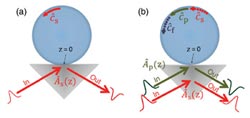Researchers Propose New Method for Achieving Nonlinear Optical Effects

In a whispering-gallery-mode resonator, a photon could become so intense that it produces a nonlinear effect, enabling quantum gates. Reprinted with permission, Yu-Zhu Sun, Yu-Ping Huang, and Prem Kumar, PRL 110, 223901 (2013).<br>
Picture two light beams intersecting one another in space. When the beams touch one another, does the light bend? Reflect? Combine into a single beam?
The answer, of course, is the light beams do nothing; they simply continue on their path. That is because in most media — including air, water, and vacuums — particles of quantized light beams called photons do not interact.
But in certain crystalline materials and with a powerful enough laser, it is possible to make photons interact with one another and take on a special set of characteristics. Known as nonlinear optical effects, these characteristics could be manipulated for applications in both the classical and quantum domains.
Researchers at Northwestern University have proposed a new method for realizing nonlinear optical effects that is more practical than previous methods. The results represent a step forward toward quantum computing and could also have interdisciplinary applications in areas like gravity wave detection and biological microscopy.
A paper describing the research, “Photonic Nonlinearities via Quantum Zeno Blockade,” was published on May 28 in Physical Review Letters.
Realizing optical nonlinear effects at a single-photon level is highly desirable but also extremely challenging; even in very strong optical nonlinear materials, the nonlinear effect is negligible to the extent that it hardly occurs. The new methodology makes the effects much more powerful and able to be realized with regularity.
The method is based on the quantum Zeno effect, a counterintuitive phenomenon originating from the famous “arrow paradox” raised more than 2,000 years ago by the philosopher Zeno of Elea, who argued that since an arrow in flight is not seen to move during any single instant, it couldn’t be moving at all. Applying this effect to realistic nonlinear optical resonator systems, the researchers found that single photons can interact strongly with each other without them ever overlapping in real space on any significant level.
The researchers propose sending light waves into a sub-millimeter-diameter disc made of a crystalline material with nonlinear properties, termed a “whispering-gallery-mode” resonator. (The term refers to enclosures, found in some cathedrals and mosques, in which sound carries along a circular wall so whispers can be clearly heard at different parts of the gallery.) A single photon could travel around the periphery of the disc, becoming so intense that it could produce a nonlinear effect sufficient to prevent additional photons from entering the resonator. The interaction between photons realized in this manner could enable “quantum gates,” the building blocks of large-scale quantum circuits, on demand.
“The beauty of this method is its practicality,” said Prem Kumar, AT&T Professor of Information Technology at Northwestern’s McCormick School of Engineering and Applied Science and one of the paper’s authors. “Existing methods to this end require complicated, extreme experimental conditions, usually involving large-volume setups and operation in near-zero-temperature environments. Ours is a sub-millimeter device that does not even require a clean room.”
Other authors are Yu-Zhu Sun, a graduate student in the Department of Physics & Astronomy at Northwestern’s Weinberg College of Arts and Sciences, and Yu-Ping Huang, research assistant professor of electrical engineering and computer science at McCormick.
This research was supported in part by the National Science Foundation (NSF), the Defense Advanced Research Projects Agency (DARPA) under the Zeno-based OptoElectronics (ZOE) program, and the United States Air Force Office of Scientific Research (USAFOSR).
Media Contact
More Information:
http://www.northwestern.eduAll latest news from the category: Physics and Astronomy
This area deals with the fundamental laws and building blocks of nature and how they interact, the properties and the behavior of matter, and research into space and time and their structures.
innovations-report provides in-depth reports and articles on subjects such as astrophysics, laser technologies, nuclear, quantum, particle and solid-state physics, nanotechnologies, planetary research and findings (Mars, Venus) and developments related to the Hubble Telescope.
Newest articles

Superradiant atoms could push the boundaries of how precisely time can be measured
Superradiant atoms can help us measure time more precisely than ever. In a new study, researchers from the University of Copenhagen present a new method for measuring the time interval,…

Ion thermoelectric conversion devices for near room temperature
The electrode sheet of the thermoelectric device consists of ionic hydrogel, which is sandwiched between the electrodes to form, and the Prussian blue on the electrode undergoes a redox reaction…

Zap Energy achieves 37-million-degree temperatures in a compact device
New publication reports record electron temperatures for a small-scale, sheared-flow-stabilized Z-pinch fusion device. In the nine decades since humans first produced fusion reactions, only a few fusion technologies have demonstrated…





















